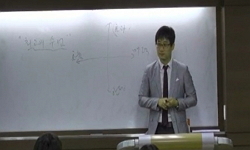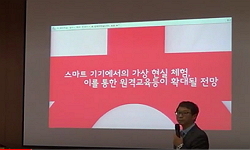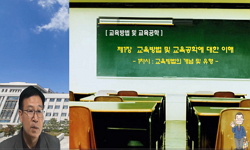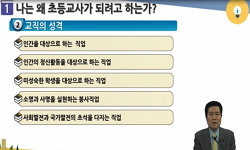[춘향전]은 숙종 말이나 영조 초에 광대의 판소리에서 비롯된 이래, 판소리뿐만 아니라, 창극, 소설, 희곡, 오페라, 영화, 뮤지컬 등 다양한 예술 양식을 통하여 변모를 거듭하며 살아있는 고...
http://chineseinput.net/에서 pinyin(병음)방식으로 중국어를 변환할 수 있습니다.
변환된 중국어를 복사하여 사용하시면 됩니다.
- 中文 을 입력하시려면 zhongwen을 입력하시고 space를누르시면됩니다.
- 北京 을 입력하시려면 beijing을 입력하시고 space를 누르시면 됩니다.
https://www.riss.kr/link?id=T8375944
- 저자
-
발행사항
서울 : 연세대학교 교육대학원, 2002
-
학위논문사항
학위논문(석사) -- 연세대학교 교육대학원 , 국어교육전공 , 2002. 8
-
발행연도
2002
-
작성언어
한국어
-
주제어
춘향전 ; 교육방법 ; 고전소설교육 ; Chunhyangjeon ; teaching method
-
KDC
376.6481 판사항(4)
-
발행국(도시)
서울
-
형태사항
iv, 111, iv p. : 도표 ; 26 cm.
-
일반주기명
지도교수: 설성경
- 소장기관
-
0
상세조회 -
0
다운로드
부가정보
국문 초록 (Abstract)
[춘향전]은 숙종 말이나 영조 초에 광대의 판소리에서 비롯된 이래, 판소리뿐만 아니라, 창극, 소설, 희곡, 오페라, 영화, 뮤지컬 등 다양한 예술 양식을 통하여 변모를 거듭하며 살아있는 고전 소설 작품으로 교수요목기부터 현재 고등학교 1학년에게 새롭게 적용되고 있는 제 7차 교육과정까지 단 한번도 빠짐없이 교과서에 실려 있어 문학 교육적 가치를 인정받고 있다고 할 수 있다. 하지만 문학 작품의 수용을 통해서 미적 감수성과 문학적 상상력을 기르고, 민족의 삶과 정서를 이해하여 한국 문학의 정체성을 확립하게 하려는 문학 교육의 목적과 고전 문학 작품의 수용을 통해 선인들의 지혜와 가치관 내지 세계관을 배우고, 민족적 정서와 사상을 이어받아 민족 문화의 전통을 오늘날에 새롭게 되살려 나가려고 하는 고전 문학 교육의 목표에 비춰 볼 때 이제까지 학교 현장에서 행해진 교수 - 학습 활동은 만족스럽지 못하다고 할 수 있다.
따라서 본 연구에서는 특히 2002학년도부터 적용되고 있는 제 7차 교육 과정에 의한 '국민 기본 공통 교육 과정'의 최종 학년인 10학년(고등학교 1학년) 국어 교과서에 실린 [춘향전]의 효율적인 수용을 위한 새로운 교수 - 학습 지도 방법을 모색해 보고자했다.
7차 교육과정의 설정 기저에 '지식은 학습자의 내적인 인지 작용에 의해서 생성된다'라는 구성주의 학습 이론이 반영되어 있음을 인지하고 지금까지의 교수 - 학습 활동에서 학습자는 교사가 제시하는 단편적인 지식을 습득하던 수동적인 입장이었으나 이제는 학습자가 보다 능동적으로 수업 활동에 참여할 수 있는 방법으로 통합 교육 방식을 제시하였다.
구성주의적 관점에서 볼 때 지식의 구성이 개인 내에서의 구성 행위든 아니면 개인간의 상호작용을 통한 구성이든 간에 이들 구성을 촉진하기 위해서는 학습 과정에서 분리보다는 통합이 바람직하다고 판단된다.
국어과의 학습 내용 영역으로 말하기, 듣기, 읽기, 쓰기, 국어지식, 문학이 있는데, 실제의 수업 활동에서는 각 영역들을 분리해서 지도하고 있다. 그러나 우리들의 실제언어 생활에서는 말하기나 듣기, 읽기, 쓰기, 언어지식, 문학 등을 따로 분리하여 생활하지 않는다. 따라서 국어과 학습 활동에 있어서 각 영역을 별도로 가르치기보다는 그것이 사용되는 상황을 고려하여 통합적으로 교육될 때 지식의 구성 행위가 촉진될 가능성이 높아질 수 있다고 본다.
7차 교육과정의 '문학'과목 교육목표에 종전에 사용되었던 문학 작품에 대한'이해와 감상'이라는 용어 대신에 '수용과 창작'이라는 용어를 사용하고 있다. 이것은 이제까지 문학의 교수 - 학습 활동에서 학습자가 작품에 대해 수동적인 입장에 있었던 점을 고려하여 7차에서는 작품 수용 주체인 학습자의 능동성을 강조한 것이다. 또한 '창작'이라는 용어의 의미도 예술 작품 창작 수준의 전문적인 글쓰기가 아니라, 작품에 대한 학습자의 문학적 반응을 다양한 방식으로 표현하는 활동을 말하는 것이다. 특히 문학 제재의 수용에 있어서 단순하게 작품을 읽고 교사 주도로 지식적인 내용을 파악하고서 학습 활동을 마무리하기보다는 읽은 것을 토의(말하기, 듣기)하고, 문학적 글쓰기(감상문 쓰기, 배경이나 결말 바꿔 쓰기, 작중
인물에게 편지 쓰기 등) 활동 과정을 수행하면 문학 작품에 대한 수용 정도가 좀더 촉진되고 풍성해질 수 있게 된다. 이러한 활동들이 바로 문학 교육에 있어서의 통합교육 활동의 하나라고 할 수 있다. 문학 교육에 있어서의 통합교육 방식은 이제까지의 지식 중심, 결과 중심의 문학 교육에서 학습자 중심, 과정 중심의 문학교육 방식으로의 획기적인 전환점이 될 수 있다.
본 연구에서는 춘향전의 효율적인 교수·학습을 위한 통합 학습 지도 방법으로 국어과의 읽기 능력 향상 방법 중 소설과 같은 문학 제재의 읽기 학습 지도 모형인 직접 읽기 활동법 - DRA(Directed Readinng Activity)- 을 활용한 문학 제재 통합 학습지도 방법과 제 7차 교육과정에서 중요시하고 있는 다양한 학습 매체를 활용하기 위한 매체 활용 통합 학습 지도 방법을 종합하여 춘향전 교수·학습을 위한 통합학습 지도 방법을 제시했다.
춘향전 교수학습을 위한 통합 학습 지도 방법의 단계를 보면 제 1단계인 교수·학습 계획 수립 단계에서는 본시 학습 목표를 설정하고, 통합 교육 지도 계획을 수립하며 제 2단계는 동기 유발 및 배경 지식·경험을 개발하는 단계로 학습 동기 유발을 위해 매체 통합 지도 방법을 활용한다. 제 3단계에서는 작품 읽기 단계로 이 단계에서는 읽기 전 단계(사전 질문 제시)와 읽기 후 활동(질의 응답 및 토의 활동)으로 구분하여 읽기와 말하기 활동을 전개하며, 원 작품의 문체나 대화 등의 분위기를 살려서 줄거리를 요약하는 활동을 함으로써 작품 읽기 활동을 마무리하게 된다. 따라서 이 단계에서는 말하기와 읽기, 쓰기의 통합 활동을 전개함으로써 작품 읽기의 효율성을 높일 수 있다. 또한 춘향전의 경우에 다양한 매체 변용이 이루어진 작품이므로 이 작품 읽기 단계에서는 문자 언어로 표현된 작품 읽기와 더불어 요즈음 청소년들에게 익숙한 영상 매체(영화, 비디오, 인터넷 동영상, 만화)를 활용한다면 자칫 따분할 수 있는 문학 수업의 한 해결방법이 될 수 있음을 밝혔다. 제 4단계 읽기 기능 학습 단계와 제 5단계 읽기 후
속 학습 활동에서는 모둠별로 과제를 부여하고 각 모둠은 과제 해결을 위해 참고 자료 및 인터넷 매체를 활용하여 모둠별 협의를 거쳐 발표를 하고 발표된 내용을 토의 활동을 통해 정리하도록 하는 활동이 이루어지게 함으로써 매체 활용 수업 및 말하기 활동이 이루어지도록 한다. 제 6단계는 내면화 및 평가 활동 단계로 이전 단계에서 이루어진 학습 활동을 종합하는 단계로 특히 문학 작품의 수용을 위해 여러 가지 문학적 글쓰기 활동(감상문 쓰기, 작가나 작중 인물에게 편지 쓰기, 결말 뒤 이야기 상상하여 쓰기, 인물 및 배경 바꿔 쓰기 등)과 매체 변용 활동(장면별 만화로 그리기, 시 쓰기, 연극으로 실연하기 등)을 통하여 작품의 내면화를 할 수 있게 된다. 이 과정에서 학습자들이 작성한 결과물들을 수행평가 자료로 활용하거나 모둠별 토의 과정, 연극으로 실연하는 과정 등에서 과정평가방법 등을 제시했다. 이처럼 문학교육에 있어서의 통합 학습 지도 방식은 이제까지 지식 중심, 결과 중심의 문학교육에서 학습자 중심, 과정 중심의 문학교육 방식으로의 획기적인 전환점이 될 수 있음을 밝혔다.
학습 지도에서는 흔히 왕도가 없다고 한다. 본 연구에서 제시한 춘향전의 교수 -학습 지도를 위한 통합 지도 방법은 수없이 많은 교수 - 학습 지도 방법 중의 하나로 이제까지 단순 지식을 배양하기 위한 고답적인 수업 방법에서 벗어나 단 한 편의 문학작품이라도 학습자들이 학습의 주체가 되어 작품에 담긴 문학 교육적, 예술적 가치를 보다 즐겁게, 효율적으로 수용할 수 있는 교수 - 학습 지도 방법이 되기를 기대하고, 통합 지도 방법의 효율성을 제고할 수 있는 다양한 학습 매체의 개발이 뒷받침되었으면 한다.
다국어 초록 (Multilingual Abstract)
Chunhyangjeon was from clown's Pansori at the end of King Sukjong or at the beginning of King Youngjo. Since then, Chunhyangjeon has been changed into diverse art forms, such as Pansori Drama, novel, opera, musical etc., as a live work of classical no...
Chunhyangjeon was from clown's Pansori at the end of King Sukjong or at the beginning of King Youngjo. Since then, Chunhyangjeon has been changed into diverse art forms, such as Pansori Drama, novel, opera, musical etc., as a live work of classical novel. It has been recognized its value of literature education, for it appeared all the textbooks from essential list of teaching(made before the regular curriculum) to the 7th curriculum(Highschool 1st grade). When we consider the objectives of literature edcation, to build esthetic sense and literature imagination by learning literature works, and to establish the identity of Korean literature by understanding the life and emotion of nation, and the objectives of classical literature education: to learn the wisdom, value and a view of the world of our ancestors and to revive the traditions of our national culture through emotion and thoughts of our nation, the activities of teaching-learning which have been done in the scene of school were satisfactory enough.
Therefore, in this analysis I intended to search a new teaching-learning methods to accept efficiently Chunhyangjeon, which appears Korean textbook of 10th grade(1st grade of Highschool), the final grade of 'national basic common curriculum'. Recognizing the constructivism education theory is reflected in the base of the 7th curriculum('Knowledge is created through the inner activity of recognition of learner'), until now the learner was in the situation of accepting passively fragmentary knowledge presented by teacher, I presented combined education methods in which the learner can take part in the classes more actively.
In the view of constructivism, I think combination is more desirable than separation in the course of learning to promote these constructions, whether the construction of knowledge is interpersonal activity or interactional activity.
In the realm of learning contents of education of Korean, there are speaking, listening, reading, writing, knowledge about Korean, and literature. Each sections are taught separately in practical learning activities. But in our language life, we do not separate speaking, listening, reading, writing, knowledge about language, and literature. Therefore, the learning activities of Korean enhance the construction of knowledge not when each sections are taught separately but when they are taught combinedly in due consideration of situation where they are used.
The education objectives of literature in the 7th curriculum use the terms 'accepting and creating' instead of 'understanding and appreciation' in literature works which used to be used. This means that the 7th curriculum empathizes the spontaneousness of learners who play a leading role in accepting the works, in considering the passive situation of learners in the course of teaching-learning activities.Also the meaning of the term 'creation' represents diverse expressing activities about the literature response of the learners, not professional writings in the level of creating art work. Especially, when students accept the literature materials, the degree of acception is more promoted and abundant if teachers lead the instructions by making students do diverse activities, such as discussion(speaking, listening), literary writing(writing impressions, rewriting the background and conclusion, writing letters to characters) than students simply read the works, do comprehension check up and conclude the instructions. These activities can be called one of the combined education activities in performing literature education. Combined education activities in performing literature education can be a epoch-making turning point from knowledge-centered, conclusion-centered literature education methods to learner-centered, process-centered methods.
In this study, I presented combined education methods, as a combined education methods of efficient teaching-learning for Chunhyangjeon, by unifying literature material education methods which utilize DRA(Directed Reading Activity)-an literature material(like novels) reading education model that belongs to one of the reading skills enhancing programs, and media utilizing combined education methods to utilize diverse education media.
Let's review the steps of combined education methods for Chunhyangjeon. In the 1st step, stage of establishing teaching-learning plan, we establish learning objectives and teaching plan of combined education. In the 2nd step, stage of motivating and developing background knowledge and experiences, we utilize combined teaching methods for students' motivating. In the 3rd step, stage of material reading, we divide it into before reading step(representing previous questions) and after reading step(questioning and answering, discussing activities), and then develop reading and speaking activities and complete material reading activities by storyline summing up activities that reflect the style of the original work and atmosphere of conversations. Thus in this step, we enhance the efficiency of material reading by developing combined activities of speaking, reading and writing. And in the case of Chunhyangjeon, adapted by diverse media, I made it sure that literature classes where students can feel bored will be more exciting if we combine written text reading with utilizing visual media(movie, video, internet moving image, cartoon) which the youth are familiar with now a days, at the stage of material reading. In the 4th step, stage of learning reading skill, and 5th step, stage of after reading activities, we manage to complete the media utilizing learning and speaking activities by charging groups with tasks. Each group represents the results by utilizing reference materials and internet media to solve the tasks. In the 6th step, stage of internalization and evaluation activities, we synthesize learning activities done previous steps. Especially, through diverse activities, such as literary writing activities(writing appreciations, writing letters to author or characters, making storylines after the ending, changing the characters and background), media changing activities(drawing a comic pictures of each scene, writing poems, performing in drama), we can internalize the work. I also presented some process evaluation methods which can be done by utilizing the results that learners wrote and watching group discussion, performing drama. I made it sure that this kind of combined education methods in literature education can be a remarkable turning point from knowledge-centered, result-centered literature education methods to learner-centered, process-centered literature education methods.
They say that there is no royal road to instruction. The combined education method for teaching-learning methods of Chunhyangjeon presented in this study is one of the numerous teaching-learning methods. I want this study to become a efficient teaching-learning methods that contain educational, artistic values within the literature works and that avoids old teaching methods which are inclined to build simple knowledge. Also I want this study supports the development of diverse learning media that can enhance the efficiency of combined education methods.
목차 (Table of Contents)
- 차례
- <국문요약>
- Ⅰ.머리말 = 1
- 1. 문제제기 및 연구사 검토 = 1
- 2. 연구 범위 및 방법 = 8
- 차례
- <국문요약>
- Ⅰ.머리말 = 1
- 1. 문제제기 및 연구사 검토 = 1
- 2. 연구 범위 및 방법 = 8
- Ⅱ. 고전소설 교육을 위한 이론적 접근 = 10
- 1. 7차 교육과정과 구성주의적 동향 = 11
- 2. 7차 교육과정의 문학 교육 목표 = 16
- 3. 7차 교육과정의 문학 교육 내용 체계, 소설의 학습 내용 = 18
- 4. 고전문학 교육의 목표 = 26
- 5. 고전문학 교육의 방법 = 29
- Ⅲ. 춘향전 교육 방법의 실제 = 43
- 1. 춘향전의 교과서 수록 현황 = 43
- 2. 문학 교육 제재로서의 춘향전 = 45
- 가. 춘향전의 문학적 장치 = 45
- 나. 춘향전의 문학 교육적 요소 = 53
- 3. 춘향전의 학습지도 방법 = 68
- 가. 문학 제재 통합(말하기, 듣기, 읽기, 쓰기) 학습지도 방법 = 70
- 나. 매체 활용 통합 학습지도 방법 = 83
- 다. 통합 학습지도 방법 = 87
- 라. 춘향전 교수 - 학습 지도안의 실제 = 88
- 마. 통합 학습지도에서의 평가 방법 = 103
- Ⅳ.결론 = 106
- 참고문헌
- Abstract












